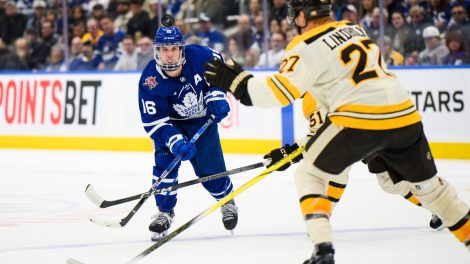ANN ARBOR, Mich. — Long before you ever get to work on staging an event this big, you have to be dreaming big. And the NHL has never dreamed quite like this before.
Wednesday’s Winter Classic at the University of Michigan won’t just be the best-attended hockey game ever played. It also marks the start of an unprecedented 62-day stretch that will see the league take six games outdoors while pushing its overall business close to $4 billion per year.
It is an audacious plan that will stretch the NHL’s events team extremely thin while testing its ability to make ice in a variety of locales. At least the first one is a slam dunk. A building known as the Big House has proven to be a perfect fit for a hockey rink—both because of the climate and the fact ice guru Dan Craig and his staff gained access to the building with plenty of time to spare.
A full two days before puck drop between the Detroit Red Wings and Toronto Maple Leafs, Michigan Stadium was already a sight to behold. All of the signage was in place and the banked stands seemed to offer much better sightlines than the baseball stadiums that have hosted outdoor games in the past. To complete the scene, a light snow fell on the bleachers. Once the stadium is crammed with 107,000 people on Wednesday afternoon it should be something special.
“This is going to be the biggest hockey game in the world and it’s likely to be that for quite some time,” John Collins, the NHL’s chief operating officer, told Sportsnet during a recent sitdown. “This will break the record.”
Officially, that record stands at the 104,173 who attended a NCAA game between Michigan and Michigan State here in 2010. There will be representatives from the Guinness Book of World Records on hand at the Winter Classic to certify that it actually gets eclipsed.
Toronto and Detroit were initially scheduled to play this game here on New Year’s Day 2013, but it ended up getting wiped out by the lockout. That forced the league to issue refunds for all 100,000-plus tickets and 81 suites before reselling them again this year.
In many ways, that wait has helped build anticipation. This is the sixth time the NHL has gone outdoors in front of national TV audiences in both Canada and the U.S. over the holidays and it’s extremely difficult to find a past participant who didn’t relish the experience. “It’s been a year and a half of just waiting for it and getting excited,” said Red Wings goalie Jimmy Howard.
That, more than anything, is why the NHL believes it can successfully stage six of these events this season. The players want to be part of them and there seems to be a high demand in the markets where they’re being staged. The Winter Classic is already sold out along with the Jan. 26 game at Yankee Stadium and the March 1 game at Chicago’s Soldier Field.
Tickets have largely been snapped up for the remaining three outdoor games and every one of them is ultimately expected to be sold, according to Collins.
“Six (outdoor games) sounds like a lot, but it’s a special year and there was an opportunity there to do it,” he said. “We felt like we could execute it well and there was an appetite in all of those markets for these games.”
The outdoor boon has gone a long way to improving the NHL’s bottom line. When the first Winter Classic was held in Buffalo seven years ago, national revenues accounted for just five percent of the league’s overall business. That number is expected to hit 22 percent this season, and it’s largely been fuelled by the additional sponsorship, merchandise and ticket sales associated with these games.
No wonder the salary cap is expected to sail past $70 million in 2014–15.
One of the biggest issues facing Collins will be finding a way to continue injecting new life into the NHL’s outdoor forays. Next year’s Winter Classic has been awarded to the Washington Capitals, and while league officials recently toured three venues in that area, sources say the 42,000-seat Nationals Park is considered the front-runner. That obviously won’t match the size and scale of this year’s game.
The roots of this particular Winter Classic matchup can be traced back to the 2011 Stanley Cup final—of all places. That was the first time NBC saw tangible evidence that it can attract a significant number of viewers for games involving Canadian teams.
“Everything kind of builds on everything else,” Collins explained. “I think that Vancouver-Boston Stanley Cup final began to change people’s perceptions really in the U.S.—that at a certain point it’s really just about great hockey and great teams and players, not necessarily about the geographic mix for the matchup.
“NBC had record ratings for the Vancouver-Boston series and I think that opened up the opportunity to really talk about Toronto coming into this game, which then opened up the opportunity to get into the Big House.”
Here we are.
On Monday afternoon, fans wearing Red Wings and Maple Leafs sweaters could already be seen dotting the streets both here in Ann Arbor and 45 minutes away in downtown Detroit. The teams are scheduled to practise at the Big House on Tuesday before facing one another a day later. When that happens it will be NHL hockey on a scale that has never been seen before.
“I’ve been to football games at the Big House so I know obviously what the crowd is like at that venue,” said Leafs winger James van Riemsdyk. “To think of it for this one, you’re probably never going to experience something like that again in your entire life. It’s pretty cool.”









